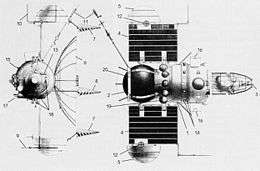Kosmos 359
 Venera 7, sister ship to Kosmos 359. | |
| Mission type | Venus lander[1] |
|---|---|
| Operator | Lavochkin |
| COSPAR ID | 1970-065A |
| SATCAT no. | 04501 |
| Mission duration | Launch failure |
| Spacecraft properties | |
| Spacecraft type | 3MV |
| Manufacturer | Lavochkin |
| Launch mass | 1,180 kilograms (2,600 lb) |
| Start of mission | |
| Launch date | 22 August 1970, 05:06:09 UTC |
| Rocket | Molniya-M 8K78M |
| Launch site | Baikonur 31/6 |
| End of mission | |
| Decay date | 06 November 1970 |
| Orbital parameters | |
| Reference system | Geocentric |
| Regime | Low Earth |
| Eccentricity | 0.05041 |
| Perigee | 210 kilometres (130 mi) |
| Apogee | 910 kilometres (570 mi) |
| Inclination | 51.5 degrees |
| Period | 95.70 minutes |
Kosmos 359 was an unmanned Soviet probe launched on 22 August 1970.[2] The probe's intended purpose was to explore Venus, but an error caused the final-stage rocket to malfunction. Leading the craft to become trapped in an elliptical orbit around Earth. The probe remained in orbit around Earth for 410 days before its orbit decayed and it reentered the atmosphere.[3] Kosmos 359 was launched five days after Venera 7 and had an identical design. Had the craft not suffered a mission-ending failure, it would have landed on Venus shortly after Venera 7.[4] To publicly acknowledge the failure of the attempted Venus lander would be a public relations disaster for the Soviet Space Program. After mission failure the Venera spacecraft was renamed Kosmos 359 in order to hide the failure from the public.[5]
Design
The lander was designed to be able to survive pressure of up to 180 bar and temperatures of 580°C.[6] This was significantly greater than what was expected to be encountered but significant uncertainties as to the surface temperatures and pressure of Venus resulted in the designers opting for a large margin of error.[6] The degree of hardening added mass to the probe which limited the amount of mass available for scientific instruments both on the probe itself and the interplanetary bus.[6]
Rocket malfunction
After reaching orbit, the main upper stage engine ignited late and shut down early after running for only twenty-five seconds. The error was ultimately attributed to an error in the DC transformer of the power supply system.[7]
Experiments
Kosmos 359 carried a limited set of scientific instruments, including a solar wind detector, cosmic-ray detector, resistance thermometer, and aneroid barometer.[8]
See also
References
- ↑ Krebs, Gunter. "Interplanetary Probes". Gunter's Space Page. Retrieved 31 October 2016.
- ↑ Huntress, Wesley; Marov, Mikhail (2011). Soviet Robots in the Solar System. Chichester, UK: Praxis Publishing. p. 420. ISBN 978-1-4419-7897-4.
- ↑ Walker, Doreen M.C Walker (March 1974). "Analysis of the Orbit of 1970-65D, Cosmos 359 Rocket". Planetary and Space Science. 22 (3). Bibcode:1974P&SS...22..391W. doi:10.1016/0032-0633(74)90072-5.
- ↑ Morov, V. I.; Bazilevsky, A. T. (2003). Space Science and Technology.
- ↑ Siddiqi, Asif A. (June 2002). Deep Space Chronicle. Washington DC: National Aeronautics and Space Administration. p. 82.
- 1 2 3 Huntress Jr, Wesley T.; Marov, Mikhail (2011). Soviet Robots in the Solar System Mission Technologies and Discoveries. Springer-Praxis. p. 235. ISBN 9781441978974.
- ↑ Siddiqi, Asif A. (June 2002). Deep Space Chronicle. Washington DC: National Aeronautics and Space Administration. p. 82.
- ↑ Siddiqi, Asif A. (June 2002). Deep Space Chronicle. Washington, D.C.: National Aeronautics and Space Administration. p. 82.